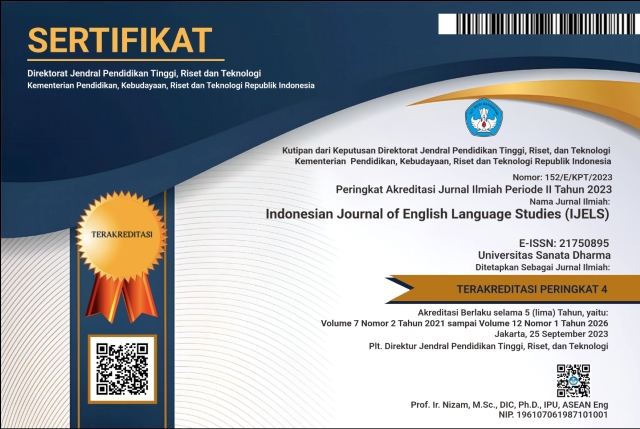An Analysis of Speech Acts Performed by A Fitness Influencer, Kayla Itsines, in Her Instagram Captions
(1) Graduate Program of English Language Studies, Universitas Sanata Dharma, Indonesia
(2) Graduate Program of English Language Studies, Universitas Sanata Dharma, Indonesia
(*) Corresponding Author
Abstract
This study seeks out the speech acts in Kayla Itsines’ Instagram captions. The captions written in the last week of January 2020 were selected as the data. There were 20 captions which consisted of 209 sentences. The results present that representative is the most frequent classification in this study. It only has one type which is claiming. It proves that in her captions, Kayla uses phatic expressions to communicate to her followers since she considers her platform as a community that shares the same interests. Hence, she can express her thoughts or feelings without having to provide the scientific evidence. Further, directive consists of 3 areas in this study; ordering, suggesting, and thanking. Ordering and suggesting have the same occurrence which is 39.75%. It presents that being a fitness influencer means being a role model. Hence, she urges her followers to make suggestions to achieve their goals. Lastly, expressive is used to express liking, congratulating, and thanking. Liking is the highest with 50% total occurrence. It aims to display her excitement towards her followers’ achievement since the goal of an influencer is to influence people to reach their goals.
Keywords
Full Text:
PDFReferences
Akram, W., & Kumar, R. (2018). A study on positive and negative effects of social media on society. International Journal of Computer Sciences and Engineering, 5(10), 347-354. http://dx.doi.org/10.26438/ijcse/v5i10.351354
Austin, J. L. (1962). How do to things with words. Oxford: Clarendon Press.
Basra, S. M., & Thoyyibah, L. (2017). A speech act analysis of teacher talk in an EFL classroom. International Journal of Education, 10(1), 73-81. http://dx.doi.org/10.17509/ije.v10i1.6848
Bayu, D. J. (2020). Selama lockdown durasi berinternet masyarakat bertambah 1 jam. Retrieved from https://databoks.katadata.co.id/datapublish/2020/11/11/selama-lockdown-durasi-berinternet-masyarakat-asia-tenggara-tambah-1-jam
Budiasih, L. T., Andayani, A., & Rohmadi, M. (2017). Illocution in speech acts by foreign students in Indonesian as a foreign language classes. Indonesian Journal of Language Teaching and Linguistics, 2(3), 213-226.
Dihni, V. A. (2021). Instagram, media sosial favorit generasi Z di dunia. Retrieved from https://databoks.katadata.co.id/datapublish/2021/09/14/instagram-media-sosial-favorit-generasi-z-di-dunia#
Forbes, F. (2021). Kayla itsines. Retrieved from https://www.forbes.com/profile/kayla-itsines/?list=top-influencers-fitness&sh=675b384b3b31
Geyser, W. ( 2021, August 17). What is an influencer? – Social media influencers defined. Retrieved from https://influencermarketinghub.com/what-is-an-influencer/
Hosain, M. S., & Liu, P. (2020). The role of social media on talent search and acquisition: Evidence from contemporary literature. Journal of Intercultural Management, 12(1), 92-137.
Intelligence, I. (2021, January 6). Influencer marketing: Social media influencer market stats. Retrieved from https://www.businessinsider.com/influencer-marketing-report?IR=T
Kowalczyk, C., & Pounders, K. (2016). Transforming celebrities through social media: The role of authenticity and emotional attachment. Journal of Product & Brand Management, 25(4), 345-356. https://doi.org/10.1108/JPBM-09-2015-0969
Leech, G. (1989). Principles of pragmatics. in R. hausser (ed.), Computation of language: An essay on syntax, semantics and pragmatics in natural man-machine communication (pp. 267–287). https://doi.org/10.1007/978-3-642-74564-5_12
MediaKix. (2021). The top 20 fitness influencers on instagram to see. Retrieved from https://mediakix.com/blog/top-fitness-influencers-instagram-millions-followers/
Miller, J. (2021). 100 top fitness influencers in 2021. Retrieved from https://www.amraandelma.com/100-top-fitness-influencers-in-2020/
Muhartoyo, M., & Kristani, K. (2013). Directive speech act in the movie "sleeping beauty". Humaniora, 4(2), 949-966.
Pessala, I. (2016). User experiences and efficiency of Instagram advertising (undergraduate thesis).
Pogoni, A. (2013). Illocutionary force indicating devices (ifid) mood in Albanian language. The 1st International Conference on Research and Educatıon – Challenges Toward the Future (ICRAE2013).
Pusparisa, Y. (2020). Pandemi tingkatkan penggunaan aplikasi digital Asia Tenggara. Retrieved from https://databoks.katadata.co.id/datapublish/2020/08/31/pandemi-tingkatkan-penggunaan-aplikasi-digital-asia-tenggara
Pusparisa, Y. (2021). Instagram, media sosial favorit generasi Z. Retrieved from https://databoks.katadata.co.id/datapublish/2021/05/16/instagram-media-sosial-favorit-generasi-z
Putra, W. R. (2018). A pragmatic analysis of illocutionary force indicating device (ifid) comprehension through quiz-based test a graduating paper (Thesis). IAIN Salatiga, Indonesia.
Scott, K. (2020, June 10). These are the world's most powerful (and highest-earning) fitness influencers for 2020. Retrieved from https://coach.nine.com.au/fitness/highest-earning-fitness-influencers-for-2020/02027202-7f90-4735-91bc-b2f5186ccf54
Searle, J. R. (1968). Austin on locutionary and illocutionary acts 1968. The Philosophical Review, 77(4), 405-424.
Searle, J. R., & Vanderveken, D. (1985). Foundations of illocutionary logic. New York: Cambridge University Press.
DOI: https://doi.org/10.24071/ijels.v10i1.5075
Refbacks
- There are currently no refbacks.

This work is licensed under a Creative Commons Attribution-ShareAlike 4.0 International License.
IJELS Journal Sinta 4 Certificate (S4 = Level 4)
We would like to inform you that Indonesian Journal of English Language Studies (IJELS) has been nationally accredited Sinta 4 by the Ministry of Education, Culture, Research and Technology of the Republic of Indonesia based on the decree No. Surat Keputusan 152/E/KPT/2023. Validity for 5 years: Vol 7 No 2, 2021 till Vol 12 No 1, 2026

This work is licensed under CC BY-SA.
Creative Commons Attribution-ShareAlike 4.0 International License
IJELS e-ISSN 2715-0895; IJELS p-ISSN 2442-790X
Indonesian Journal of English Language Studies (IJELS) is published twice a year, namely in March and September, by the English Language Studies (ELS) of the Graduate Program of Sanata Dharma University, Yogyakarta, Indonesia.


 IJELS p-ISSN:
IJELS p-ISSN: 









